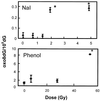A reliable assessment of 8-oxo-2-deoxyguanosine levels in nuclear and mitochondrial DNA using the sodium iodide method to isolate DNA
- PMID: 11353081
- PMCID: PMC55450
- DOI: 10.1093/nar/29.10.2117
A reliable assessment of 8-oxo-2-deoxyguanosine levels in nuclear and mitochondrial DNA using the sodium iodide method to isolate DNA
Abstract
A major controversy in the area of DNA biochemistry concerns the actual in vivo levels of oxidative damage in DNA. We show here that 8-oxo-2-deoxyguanosine (oxo8dG) generation during DNA isolation is eliminated using the sodium iodide (NaI) isolation method and that the level of oxo8dG in nuclear DNA (nDNA) is almost one-hundredth of the level obtained using the classical phenol method. We found using NaI that the ratio of oxo8dG/10(5 )deoxyguanosine (dG) in nDNA isolated from mouse tissues ranged from 0.032 +/- 0.002 for liver to 0.015 +/- 0.003 for brain. We observed a significant increase (10-fold) in oxo8dG in nDNA isolated from liver tissue after 2 Gy of gamma-irradiation when NaI was used to isolate DNA. The turnover of oxo8dG in nDNA was rapid, e.g. disappearance of oxo8dG in the mouse liver in vivo after gamma-irradiation had a half-life of 11 min. The levels of oxo8dG in mitochondrial DNA isolated from liver, heart and brain were 6-, 16- and 23-fold higher than nDNA from these tissues. Thus, our results showed that the steady-state levels of oxo8dG in mouse tissues range from 180 to 360 lesions in the nuclear genome and from one to two lesions in 100 mitochondrial genomes.
Figures




References
-
- Beckman K.B. and Ames,B.N. (1999) Endogenous oxidative damage of mtDNA. Mutat. Res., 424, 51–58. - PubMed
-
- Ames B.N. and Gold,L.S. (1991) Endogenous mutagens and the causes of aging and cancer. Mutat. Res., 250, 3–16. - PubMed
-
- Dizdaroglu M. (1998) Facts about the artifacts in the measurement of oxidative DNA base damage by gas chromatography-mass spectrometry. Free Radic. Res., 29, 551–563. - PubMed
Publication types
MeSH terms
Substances
Grants and funding
LinkOut - more resources
Full Text Sources
Other Literature Sources

